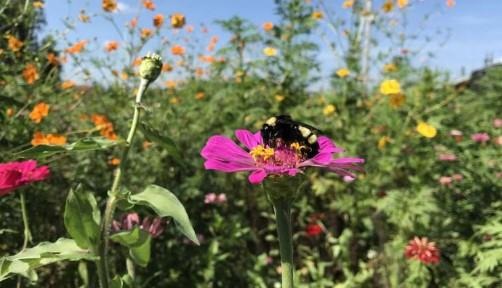By Mick Kulikowski
Although not quite the bee's knees, a three-year effort to conserve bee populations by introducing pollinator habitat in North Carolina agricultural areas showed some positive effects, as bee abundance and diversity increased in the studied areas.

A queen bee enjoys an agricultural pollinator habitat
But results of a study examining the program's effectiveness also showed that the quality of the habitat played a key role in these positive effects, and that habitat quality could be impacted by the way the areas are maintained over time.
North Carolina State University researchers studied the effects of a N.C. Department of Agriculture program that installed pollinator-friendly flowers on 16 agricultural research stations from the mountains to the coast from 2016-18. Mixtures of planted bee-friendly flowers were evaluated for their effectiveness in supporting bee populations—with the goal of increasing the abundance and diversity of bees.
The research is published in the journal Frontiers in Ecology and Evolution.
Honey bee specialist David Tarpy, professor of entomology at NC State and a co-author of a paper describing the research, recalled thinking that the program was a unique opportunity to study government-led conservation efforts. "We should get in on the ground floor and measure this and see if it has an effect from day 0, not after the fact," he recalls.
"We didn't want to let that 'natural laboratory' opportunity pass without actually recording the data," added Hannah Levenson, a postdoctoral research scholar at NC State and corresponding author of the paper.
Researchers visited all 16 sites four times each year and caught bees in nets and in cups—called bee bowls—that were painted to mimic the UV reflection of flowers. In all, the researchers collected more than 16,000 bees from 128 different bee species.
Results showed bee abundance increased over time, with more bees collected in 2018 than in 2016. Meanwhile, the diversity of species increased in 2017 and then dropped slightly in 2018, although both years showed large improvement over 2016.
"We were really happy to see increases in the abundance and number of bee species found over time," Levenson said. "It was also exciting to see how many species we documented, especially for studying one kind of habitat. This study was limited to agricultural areas but we still found nearly 130 bee species."
Click here to see more...